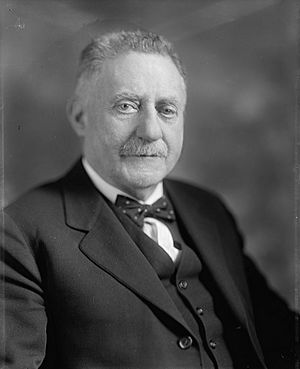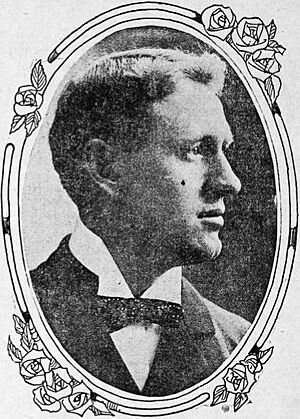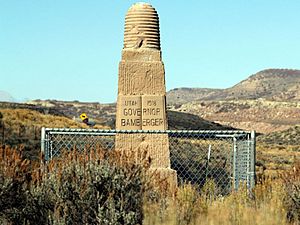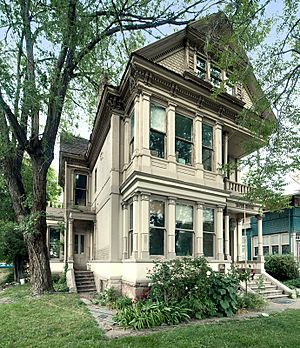Simon Bamberger facts for kids
Quick facts for kids
Simon Bamberger
|
|
|---|---|
 |
|
| 4th Governor of Utah | |
| In office January 1, 1917 – January 3, 1921 |
|
| Preceded by | William Spry |
| Succeeded by | Charles R. Mabey |
| Member of the Utah Senate | |
| In office 1903–1913 |
|
| Personal details | |
| Born | February 27, 1845 Darmstadt-Eberstadt, Germany |
| Died | October 6, 1926 (aged 81) Salt Lake City, Utah, U.S. |
| Political party | Democratic |
| Spouse | Ida Maas |
| Children | 4 |
Simon Bamberger (February 27, 1845 – October 6, 1926) was an important leader in Utah. He served as the fourth Governor of Utah from 1917 to 1921. He was the first governor of Utah who was not a member of The Church of Jesus Christ of Latter-day Saints. He was also the first Democrat and the first, and only, Jewish governor of Utah.
Contents
Early Life and Adventures
Simon Bamberger was born in Germany on February 27, 1845. His family name was Bamberger. When he was 14, he moved to the United States. This was just before the American Civil War started.
He first arrived in New York City. He planned to go to Cincinnati, Ohio, which was a big center for German people. But he missed his train connection. He ended up in Indianapolis and then Terre Haute, Indiana. He stayed there until the Civil War ended in 1865.
After the war, he moved to St. Louis, Missouri. There, he started a clothing company with his brother. But the business failed. Simon then decided to move to Utah, which was still a territory and not very settled. In 1881, he married Ida Maas, and they had four children.
Utah Entrepreneur and Builder
When Simon Bamberger first arrived in Utah, he ran a small hotel in Ogden, Utah. Later, he moved to Salt Lake City and ran the Delmonico Hotel.
In 1872, he invested in a silver mine called the Centennial Eureka Mine. Two years later, they found a lot of silver! This made Bamberger a millionaire. He thought about retiring, but he loved to build things.
He started building railroads to connect Salt Lake City to mining areas. These railroads helped transport goods and people. He also built Lagoon, a large amusement park in Farmington, Utah. This park became a popular place for families to visit.
Bamberger also tried to create a Jewish farming community in Clarion, Utah. He believed it was important for people to connect with the land. Unfortunately, this community did not last very long.
The Bamberger Railroad
In 1908, Simon Bamberger built a railroad called the Salt Lake and Ogden. It connected Salt Lake City to Ogden. In 1910, it became an electric train line. Eventually, it was renamed the Bamberger Railroad, after his family.
The railroad was very important for moving goods and people. It even had an amusement park and a lake built along its route. This encouraged more people to ride the train, especially in the summer.
Even during the Great Depression, the Bamberger Railroad did well. It had a strong business moving freight. It even bought new, fast trains in 1938. The railroad continued to operate until 1955.
Becoming a Politician
Simon Bamberger also became very involved in politics. He served on the Salt Lake City Board of Education from 1898 to 1903. He believed that everyone should have access to free public education. He even used his own money to help keep the public schools running.
In 1902, he was elected to the Utah State Senate. He was known for being smart and funny. He was also good at getting things done.
In 1916, he decided to run for Governor of Utah. Being Jewish was unusual for a politician in Utah at that time. Some people even spread mean flyers about him. But many important citizens spoke out against this.
Bamberger's sense of humor helped him win people over. Once, he met a group of Norwegian immigrants who were members of The Church of Jesus Christ of Latter-day Saints. Their leader said they wouldn't support any "damned Gentile." (At that time, some members of the Church called non-members "Gentiles.") Bamberger quickly replied, "As a Jew, I've been called many bad names, but this is the first time I've been called a 'damned Gentile'!" The people laughed and started to support him. They even called him an "Israelite."
During his campaign, a leader from The Church of Jesus Christ of Latter-day Saints, Brigham H. Roberts, supported Bamberger. He said that people should not choose leaders based on their church. Bamberger won the election easily. He promised to sign a law to stop the sale of alcohol, which was a big issue at the time.
A Governor Who Made a Difference
Even though Simon Bamberger was governor for only one term (four years), he achieved a lot. When he started, Utah had a large budget deficit (meaning the state spent more money than it took in). He ordered a check of all state departments. He found and recovered a million dollars that had been misused. This was a lot of money back then!
Bamberger worked with the state legislature to pass many new laws. He was a "progressive" governor. This meant he wanted to make things better for everyone. He believed in:
- Fair rules for businesses.
- Giving women the right to vote.
- Stopping child labor.
- Making sure people had good public education.
- Stopping the sale of alcohol (Prohibition).
Under his leadership, Utah passed many important laws:
- A law to stop corruption and unfair deals between companies and public officials.
- A law that allowed workers to form unions.
- A statewide Prohibition law, even before it became a national law.
- Laws to regulate the stock market. This helped protect people's investments. Utah was one of the first states to do this.
- Laws for Workers' Compensation. This helped workers who got hurt on the job.
- Laws making high school attendance required.
- A tax on mines, even though he owned mines himself!
- He pushed for better roads across the state.
- He called a special meeting to approve the 19th Amendment. This amendment gave women across the United States the right to vote in 1920. Utah women had already had this right since 1869.
Other changes he made included:
- Creating a public health department.
- Setting up a commission to control the prices of gas and electricity.
- Allowing judges to be elected by the people.
- Making the school year longer.
- Creating a water rights commission to manage water use. This was very important in a dry state like Utah.
Later Years
Simon Bamberger was 75 years old when his term as governor ended. He decided not to run for reelection. He left office in 1921 and went back to managing his businesses. He passed away on October 6, 1926, and was buried in Salt Lake City.




